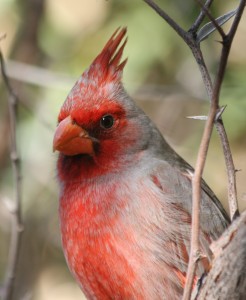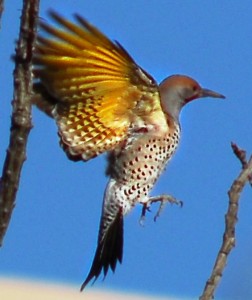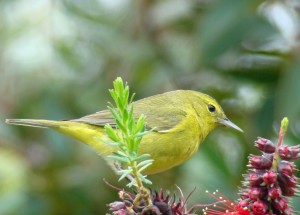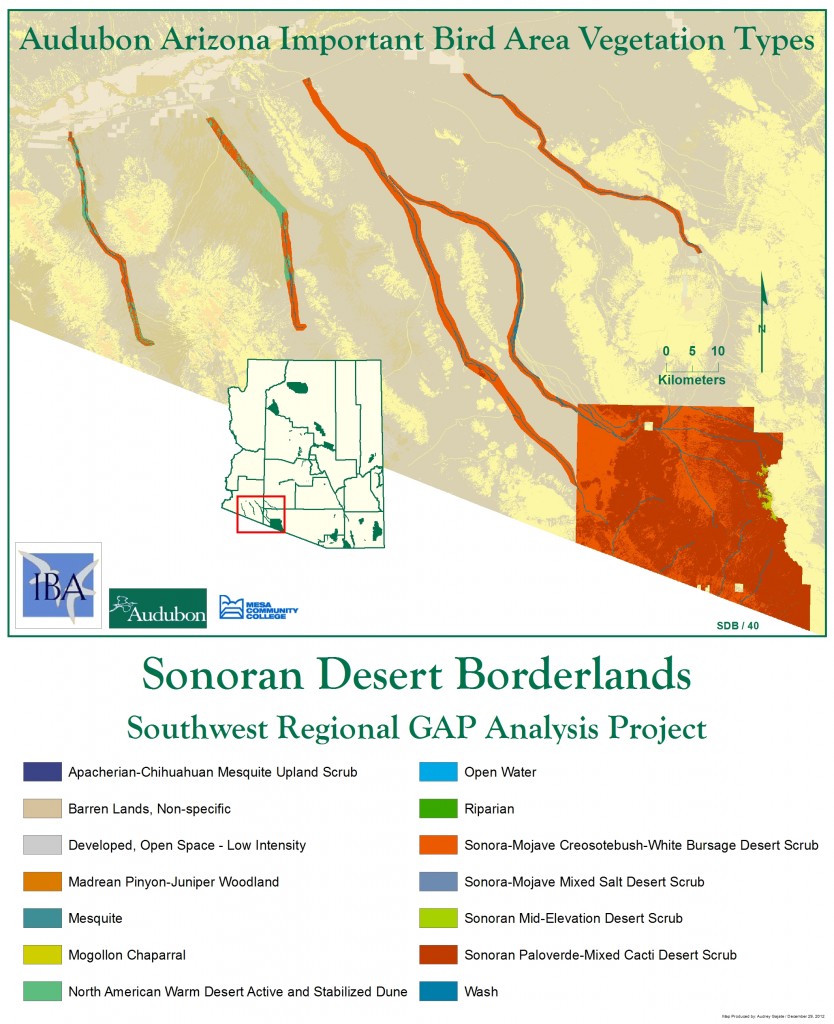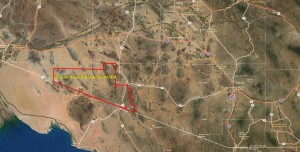Location: UTM 3545154 N 326281 E NAD 83
Counties: Pima and Yuma
Site Status: Identified 07/2010
Ownership: Federal, USFWS and NPS
Area: 1,851 square miles, 1,184,668 acres
Criteria: D1 – Site Important to Special Status Avian Species (Gilded Flicker, Bendire’s Thrasher, Le Conte’s Thrasher, Sage Thrasher, Costa’s Hummingbird, Abert’s Towhee, Brewer’s Sparrow, Cactus Ferruginous Pygmy Owl, Elf Owl, and Loggerhead Shrike)
D3 – Rare, Unique, or Exceptional Representative Habitat/Ecological Community: Sonoran Desertscrub Ecosystem 
 Site Description: This IBA includes the entire Cabeza Prieta NWR and Organ Pipe National Monument. There is a standing request for permission from the DOD to include the Barry Goldwater Air Force Range in the IBA. This is the largest IBA in Arizona and one of the most remote. Cabeza Prieta is the third largest National Wildlife Refuge in the lower 48 states and contains Arizona’s largest Wilderness area. As some of the most pristine and isolated desert landscape in America, the various plant communities contained within the refuge provide vital habitat to many native bird species, including species of special status. Creosote flats, bursage dotted bajadas, and sonoran desert uplands with saguaro, mesquite, paloverde, ironwood, ocotillo and cholla personify the vegetative landscape and provide essential habitat for many bird species.
Site Description: This IBA includes the entire Cabeza Prieta NWR and Organ Pipe National Monument. There is a standing request for permission from the DOD to include the Barry Goldwater Air Force Range in the IBA. This is the largest IBA in Arizona and one of the most remote. Cabeza Prieta is the third largest National Wildlife Refuge in the lower 48 states and contains Arizona’s largest Wilderness area. As some of the most pristine and isolated desert landscape in America, the various plant communities contained within the refuge provide vital habitat to many native bird species, including species of special status. Creosote flats, bursage dotted bajadas, and sonoran desert uplands with saguaro, mesquite, paloverde, ironwood, ocotillo and cholla personify the vegetative landscape and provide essential habitat for many bird species. 
As a protected area, Organ Pipe Cactus National Monument allows the life of the Sonoran Desert to flourish under nearly ideal wilderness conditions. The monument is an outstanding natural preserve where one of the of the Earth’s major ecosystems survives almost unspoiled. Positioned north of the Sea of Cortez, the Organ Pipe Cactus NM is along a primary migratory flyway. American Bird Conservancy identified this site in 2001 as one of 500 most important bird areas in the United States. (http://www.nps.gov/orpi/naturescience/index.htm) Organ Pipe Cactus National Monument exhibits an extraordinary collection of Sonoran Desert plants. Twenty-six species of cactus have mastered the art of living in this place, including the park’s namesake and the giant saguaro. Elephant Tree (Bursera microphylla) provides a winter food resource (seeds) for Gray Vireo.
Ornithological Summary:
Cabeza Prieta NWR: Cabeza Prieta Refuge bird records indicate 212 species recorded over its history (USFWS 1991). Twenty-seven IBA surveys were conducted from February 2009 to March 2010 covering Daniel’s Arroyo Valley, San Cristobal Wash Valley, Chinaman Flats Valley North, Chinaman Flats Valley South, Sheep Mountain Valley, Antelope Hills Valley, Papago Wash Valley, Agua Dulce Valley, and O’Neil Hills Valley (58 species recorded). Seven Audubon Watchlist species were found here during these IBA surveys. These species are: Gilded Flicker (Red listed, high of 1.7/lin. km), Bendire’s Thrasher (Red listed, high of 0.1/lin. km), Brewer’s Sparrow (Yellow listed, high of 1.6/lin. km) Costa’s Hummingbird (Yellow listed, high of 1.0/lin. km), Sage Sparrow (Yellow listed, high of 0.9/lin. km), Le Conte’s Thrasher (Yellow listed, high of 0.3/lin. km) & Abert’s Towhee (Yellow listed, high of 0.3/lin. km). Loggerhead Shrike (high of 1.2/lin. km), a USFWS Bird of Conservation Concern, was also found in abundance along with Sage Thrasher (high of 0.5/lin. km) which is listed as a Partners in Flight Conservation Priority Species and an AZ Threatened Bird, Species of Greatest Conservation Need. The Refuge conducted surveys for Le Conte’s Thrasher in 2009 and 2010, recording 23 and 19 Le Conte’s Thrasher detections, in Growler Valley and San Cristobal Valleys, respectively, and adding an additional two bird species detected over the last two-year period of bird studies (Scott’s Oriole and Western Bluebird).
This National Wildlife Refuge also meets the IBA Criterion, Rare, Unique, or Exceptional Representative Habitat/Ecological Community, as it is a prime example of Sonoran desertscub vegetation. This area is also recognized as one of the last remaining undisturbed and isolated desert terrains in the United States. This refuge supports a full range of bird species expected in such a habitat and populations of Gambel’s Quail, American Kestrel, Greater Roadrunner, White-throated Swift, Say’s Phoebe, Ash-throated Flycatcher, Verdin, Cactus Wren, Rock Wren, Black-tailed Gnatcatcher, Curve-billed Thrasher, Phainopepla, Black-throated Sparrow, White-crowned Sparrow, Northern Cardinal, Pyrrhuloxia, House Finch, and Lesser Goldfinch can be found here.
Other notable highlights of the two-year IBA surveys are some birds of overall sparse distribution in Arizona, including: A group of four Long-eared Owls in Daniel’s Arroyo Valley, Black Vulture (found here at the extreme northwestern part of their continental distribution) and an immature Golden Eagle in Chinaman Flat South Valley.
Organ Pipe NM: Organ Pipe Cactus National Monument is an excellent example of an Arizona Upland ecosystem within the Sonoran desertscrub biome. In early spring of 2009 and 2010, five canyons were surveyed by Audubon IBA bird survey transects: Alamo Canyon, Arch Canyon, Estes Canyon, and Victoria Mine Trail (VMT surveyed only in 2009). Audubon IBA surveys were restricted to the Ajo Range and a small section of the Sonoyta Mountains (by VMT), as there were park restrictions due to safety concerns preventing access to the Puerto Blanco Mountains, Bates Mountains, Cipriano Hills, and Quitobaquito Hills and Springs. These intensive Audubon surveys show this park to be important to at least five special conservation status species in Arizona. Additionally, our surveys found this park is most important for its outstanding xeric riparian and upland sonoran desert habitats supporting an exceptionally diverse avian community.
Three Audubon WatchList species were found in abundance, Gilded Flicker (Audubon WatchList-Red listed, high of 2.03 birds/lin. km), Costa’s Hummingbird (Audubon WatchList-Yellow listed, high of 2.09 birds/lin. km), and Elf Owl (Audubon WatchList-Yellow listed), which has been recorded in all canyons and bajadas of the Ajo Range, and throughout other ranges of the park, but explicit quantitative data is lacking. Plus two other bird species of concern were observed here, the Loggerhead Shrike (USFWS Bird of Conservation Concern BCR 35, high of 0.45 birds/lin. km), and the Cactus Ferruginous Pygmy-Owl (AZGFD Species of Greatest Conservation Need, Tier 1a), for which Audubon IBA surveys found one nest territory in 2009, and two nest territories in 2010, both within canyons of the Ajo Range. Several other species of conservation status were observed in Organ Pipe Cactus NM, but not in high abundance. Abert’s Towhee (Audubon WatchList-Yellow listed), along with Hooded Oriole (USFWS Bird of Conservation Concern BCR 35) and Gray Flycatcher (AZ PIF Priority), were each recorded once.
Organ Pipe Cactus NM also meets the IBA Criterion, Rare, Unique or Exceptional Representative Habitat/ Ecological Community as this area is a premier example of xeric southwestern riparian community and Arizona Uplands Sonoran desertscrub. Organ Pipe provides habitat for an outstanding number of native resident species associated with canyon xeric-riparian areas, such as: Cooper’s Hawk, White-throated Swift, Ladder-backed Woodpecker, Black Phoebe, Ash-throated Flycatcher, Canyon Wren, Bewick’s Wren, House Wren, Blue-gray Gnatcatcher, Phainopepla, Canyon Towhee, Abert’s Towhee (apparently on the edge of its range), Northern Cardinal, and Pyrrhuloxia. Additionally the park supports many over-wintering species and migrants that find the lush, dense riparian habitat within its canyons ideal for their needs, including: Gray Flycatcher, “Western” Flycatcher, Violet-green Swallow species, Ruby-crowned Kinglet, Western Bluebird, Townsend’s Solitaire, Hermit Thrush, American Robin, Orange-crowned Warbler, Wilson’s Warbler, Green-tailed Towhee, Spotted Towhee, Rufous-crowned Sparrow, Chipping Sparrow, Lincoln’s Sparrow, White-crowned Sparrow, Dark-eyed Junco, and Hooded Oriole.
Conservation Issues: As the Refuge shares a 56-mile international border with Sonora, Mexico, it is not surprising that two of the most important threats to the ecology of Cabeza Prieta National Wildlife Refuge are the impacts of illegal border crossers and the actions of Border Patrol officers attempting to apprehend them. The rules of the refuge prohibit any vehicle traffic off of designated public use roads as the tracks made by vehicles could remain for hundreds of years in this fragile desert ecosystem. Despite this prohibition, many tracks, some of them deeply rutted, were observed by IBA surveyors miles from any road presumably from both illegal border crosser traffic and Border Patrol vehicles attempting to intercept such traffic. There is also a significant amount of refuse left all over the Refuge by illegal border crossers and drug smugglers including plastic water jugs, abandoned vehicles and other inorganic waste.
Another concern is that most of the Refuge falls within the air space of the Barry M. Goldwater Air Force Range. Numerous low-flying aircraft cross the Refuge on their way to air-to-air bombing and gunnery ranges located to the north and some military training exercises occur over the Refuge. Evidence of such exercises can be found on the Refuge in the form of metal flare casings and other waste from ordnance and ammunition.
Impacts such as the off-road vehicle damage to soil and vegetation are difficult to deal with yet impossible to ignore as their impacts are potentially devastating to the ecology of the area.


